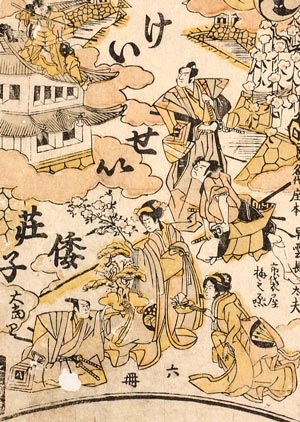| CHď NO MICHIYUKI |
| Play title | Keisei Yamato Z˘shi |
| Authors | Namiki Gohŕ, Namiki Jűsuke, Tsutsui Hanji (drama) Miyazono Mojidayű, Miyazono Kumidayű, Tsurusawa Otogor˘ (music) |
| History |
The 6-act play "Keisei Yamato Z˘shi" was written directly for Kabuki by the playwright Namiki Gohŕ, with the help of Namiki Jűsuke and Tsutsui Hanji. It was produced in the 1st lunar month of 1784 by the zamoto Arashi Tanin in ďsaka at the Naka no Shibai [casting]. The original musical accompaniment was in the Miyazono style. It changed to Gidayű when the drama was adapted to the puppet theater. The drama and its michiyuki went to oblivion from the beginning of the Meiji era. It was revived for the puppet theater in October 1955 and, using the script written for the puppets, adapted for Kabuki in July 1956 at the Kabukiza, starring Matsumoto K˘shir˘ VIII and Nakamura Utaemon VI in the roles of Kond˘ Sukekuni and Komaki. Takechi Tetsuji revived it with two long-forgotten acts in June 1962 at the Kabukiza. |
| Structure |
The michiyuki "Ch˘ no Michiyuki", which is also called "Sukekuni Komaki", is the fifth act of "Keisei Yamato Z˘shi". |
| Key words | Shosagoto Michiyuki Gidayű Miyazono |
| Summary |
"Ch˘ no Michiyuki" is a travel dance about two butterflies which are the spirits of the tragic young lovers Komaki and Sukekuni, who chose to be united in death since their families would not allow them to be together in life. The two butterflies fly among the flowers, recalling their memories, like their first meeting when they fell in love with each other. They met by chance at the local shrine festival when Komaki's long sleeve was caught on Sukekuni's scabbard. Unfortunately for these two young people, there was a feud between their families, which made their marriage impossible. Moreover, their death as substitutes for another couple, Kitabatake Yukienosuke and Princess Yayoi, was also a necessity. They were reincarnated after their death as a pair of butterflies, free to fly together and remember their previous life amid the flowers. This summary was made by Sh˘riya Aragor˘ using a text written by Jean Wilson (1999) |
| Comments |
"It is unique in the Kabuki repertoire of such dances because the lovers are already dead. The most interesting feature was the opening of the play in complete darkness with k˘ken stage hands manipulating two giant luminous butterflies around the stage prior to the actors' entrance." (Jean Wilson 1999) |
 |
|
|
Illustrated playbill for the production of "Keisei Yamato Z˘shi" in the 3rd lunar month of 1809 at the Kitagawa no Shibai |
|
|
|
| Contact | Main | Top | Updates | Actors | Plays | Playwrights | Programs | Links | FAQ | Glossary | Chronology | Illustrations | Prints | Characters | Derivatives | Theaters | Coming soon | News |